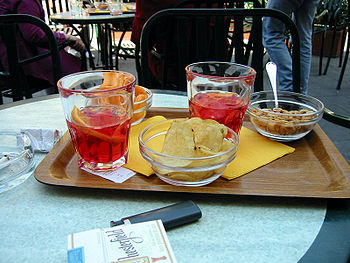- Apéritif and digestif
-
 Two glasses of apéritifs (Campari with carbonated water) served with potato crisps and peanuts as appetizers.
Two glasses of apéritifs (Campari with carbonated water) served with potato crisps and peanuts as appetizers.
Apéritifs and digestifs (
 /əˈpɛrɨtiːf/ and /diːʒɛˈstiːf/) are alcoholic drinks that are normally served with meals.
/əˈpɛrɨtiːf/ and /diːʒɛˈstiːf/) are alcoholic drinks that are normally served with meals.Contents
Apéritifs
An apéritif (also spelled aperitif) is usually served before a meal to stimulate the appetite. This contrasts with digestifs, which are served at the end of a meal to purportedly aid digestion. Common choices are vermouth, champagne, fino, and any still, dry, light white wine.
"Apéritif" may also refer to a snack that precedes a meal. This includes an amuse-bouche, such as crackers, cheese, pâté or olives.[1][2]
"Apéritif" is a French word derived from the Latin verb aperire, which means “to open.”
Digestifs
If a digestif is a bitters, it will contain bitter or carminative herbs, which are thought to aid digestion.[3] Digestifs are usually taken straight (neat) and generally contain more alcohol than apéritifs. Common choices are amari, bitters, brandy, grappa, herbal liqueur, limoncello, ouzo, tequila, and whisky.
Some fortified wines are served as digestifs — for example, sherry, vermouth, port, and madeira.
History
The apéritif was introduced in 1846, when a French chemist, Joseph Dubonnet, created the eponymous wine-based drink as a means of delivering malaria-fighting quinine. The medicine was a bitter brew, so he developed a formula of herbs and spices to mask quinine's sharp flavor, and it worked so well that the recipe has remained well-guarded ever since. French Foreign Legion soldiers made use of it in mosquito-infested Northern Africa. Joseph's wife was so fond of the drink that she had all her friends try it, and its popularity spread.
Some say[who?] that the concept of drinking a small amount of alcohol before a meal dates back to the ancient Egyptians. Main records[which?], however, show that the apéritif first appeared in 1786 in Turin, Italy, when Antonio Benedetto Carpano invented vermouth in this city. In later years, vermouth was produced and sold by such well-known companies as Martini, Cinzano, Dolin and Noilly Prat.
Apéritifs were already widespread in the 19th century in Italy, where they were being served in fashionable cafes in Rome, Venice, Florence, Milan, Turin, and Naples. Apéritifs became very popular in Europe in the late 19th century. The popularity in Europe crossed the Atlantic and by 1900, they were also commonly served in the United States. The apéritif recrossed the Atlantic in the 1970s: the habit of a substantial food offering with the purchase of a drink during "Happy Hour" in the United States pushed the development of a more food-heavy apéritif in Italy as well.[4] In Spain and in some countries of Latin America, apéritifs have been a staple of tapas cuisine for centuries.
Types
There is no single alcoholic drink that is always served as an apéritif. Fortified wine, liqueur, and dry champagne are probably the most common choices.
- In France, the apéritif varies from region to region, although pastis and Picon are the most common.
- In Italy, vermouth or amaro may be served. Popular brands of bitters are Byrrh, Campari, Cinzano, Salers and Suze.
- In Greece, ouzo is a popular choice.
- In the Eastern Mediterranean, arak is served with meze.
See also
References
- ^ Lichine, Alexis. Alexis Lichine’s New Encyclopedia of Wines & Spirits (5th edition) (New York: Alfred A. Knopf, 1987), 75.
- ^ Robinson, Jancis. The Oxford Companion to Wine (3rd edition) (Oxford University Press: 2006), 26.
- ^ Walton, Stuart; Miller (2002). Spirits & Liqueurs Cookbook. New York: Hermes House. pp. 16–17. ISBN 1843094983.
- ^ "The History of the Aperitivo". http://www.foodinitaly.org/the-history-of-the-aperitivo.
Categories:- Alcoholic beverages
- French loanwords
Wikimedia Foundation. 2010.

